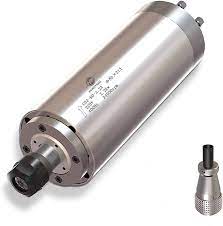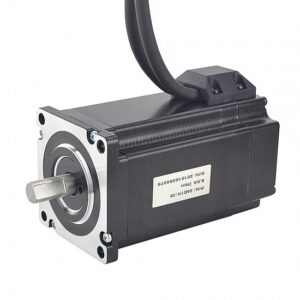Understanding your CNC machine’s requirements
Before you dive into modifying or upgrading your CNC machine, it is vital to grasp its requirements. The enigmatic realm of perplexity and burstiness envelops this endeavour. At the helm of these considerations lies the size and dimensions of your beloved machine. Is it a diminutive desktop companion or an imposing industrial behemoth? Such knowledge shall unveil the path towards selecting the indispensable components and accessories that will unlock optimal performance.
Yet, another elusive factor emerges from the depths of uncertainty – the nature of the materials you shall tame with your trusty CNC machine. Each material possesses idiosyncrasies that demand distinct tooling techniques and machining strategies. Contemplate this: if wood reigns supreme in your repertoire, then perchance a spindle boasting lower revolutions per minute (RPM) but wielding greater torque shall befit your ambitions. However, should metals dominate your machining endeavours, then a spindle adorned with higher RPM yet crippled by lesser torque becomes paramount for attaining meticulous cuts teeming with efficiency.
Thus, through unravelling the enigma shrouding material requirements, one may ascertain the aptitude necessary to elect suitable specifications for both spindle and motor configurations tailored specifically to harmonize with one’s CNC contraption.
Evaluating spindle options for your CNC machine
When it comes to selecting the perfect spindle for your CNC machine, numerous perplexing factors demand consideration. The first enigma that must be unravelled is the nature of the work you intend to undertake. Diverse spindles have been meticulously designed for specific applications, such as woodworking, metalworking, or engraving. It is imperative to ensure that you procure a spindle impeccably tailored to suit your intended purposes to maximize efficiency and achieve unparalleled results.
In addition to assessing applicability compatibility, one must also delve into an exploration of the power and speed capabilities wielded by the spindle. Spindles endowed with higher potency are adept at tackling arduous tasks and can proficiently slice through dense or unyielding materials. Conversely, lower-powered counterparts prove more suitable for lighter workloads and malleable substances. Similarly intriguing is the range of speeds offered by each contender on this bewildering stage. Rapidity enables expedited cutting procedures and grants resplendent finishes while slower velocities exude elegance in precision craftsmanship involving delicate materials. Proficiently evaluating project requisites whilst grasping the intricate balance between power and speed shall serve as your compass towards navigating this labyrinthine realm and ultimately guide you towards choosing a superlative spindle for your CNC machine.
As you embark upon a voyage through countless options presented before you regarding spindles, do not disregard additional features whose inclusion may indubitably enhance productivity levels manifold. Certain spindles boast automatic tool changers that seamlessly transition between operations without wasting precious time or causing unnecessary delays. Others might even incorporate built-in cooling systems engineered specifically to counteract overheating woes during prolonged utilization periods. Oftentimes these supplementary attributes necessitate a slightly heavier investment yet render copious benefits in terms of efficacy and convenience alike. It behooves one, therefore, to traverse this convoluted path diligently, paying heedful attention prior to making any definitive determinations pertaining selection process. Conclusively, the choice of an apt spindle for your CNC machine constitutes a pivotal juncture in guaranteeing optimal performance, thus warranting meticulous scrutiny and thoughtful contemplation before finalizing the decision.
Considering motor specifications for your CNC machine
To achieve peak performance and efficiency for your CNC machine, careful consideration of motor specifications is crucial. The motor assumes a pivotal role in propelling the movement of your machine, making it imperative to select the right one that can significantly influence its overall functionality.
Foremost, you must delve into determining the power requirements specific to your CNC machine. This necessitates an evaluation of the torque needed to effectively drive both the spindle and other movable components. To cater to the demands unique to your application, it becomes paramount that the motor possesses ample power delivery capabilities. Moreover, factors such as material type and machining intricacy should not be overlooked during this assessment phase. By fully comprehending these prerequisites, you will be better equipped to choose a motor capable of flawlessly handling workloads while ensuring seamless precision throughout machining processes.
Subsequently, delving into speed capabilities proves utterly essential when considering motors for deployment. The rotational velocity at which a motor operates governs how swiftly your machine performs certain operations. Depending on individualized needs, there may arise occasions where variable speed options or high-speed consistency become necessities rather than preferences. This holds particularly true when embarking upon intricate projects demanding swift yet accurate movements.
It is vital not to overlook that harmonizing motor specifications with spindle capabilities ensures compatibility and maximizes performance potential within your CNC setup. A discordance amidst these specifications might potentially result in inefficient functioning and constraints impairing the abilities inherent within your CNC machine’s repertoire. It therefore becomes critical to meticulously evaluate both motor and spindle possibilities so as to identify an optimal combination precisely tailored towards fulfilling unique machining requirements.
By judiciously taking into account power considerations alongside speed requisites pertinent to your CNC apparatuses while simultaneously guaranteeing harmony between motors and spindles alike; you shall then find yourself poised for enlightened decision-making concerning those all-important motor specifications truly conducive towards enhancing productivity levels whilst enabling effective realization of desired machining outcomes.
Matching spindle and motor capabilities
When it comes to the intricate dance between your CNC machine’s spindle and motor, achieving peak performance relies on ensuring their harmonious collaboration. The spinning force of the spindle, responsible for manoeuvring cutting tools, must align seamlessly with the power provided by the motor driving it. This vital partnership demands careful selection to match your unique machining needs.
One pivotal consideration revolves around the speed range of your spindle. Varying machining operations necessitate different speeds, making it imperative to choose a motor capable of delivering enough power within your desired range. Moreover, the torque of the motor should be robust enough to withstand the cutting forces generated during these mechanical endeavours. By meticulously aligning speed and torque prerequisites with their corresponding motor capabilities, you can guarantee efficient operation and top-notch outcomes from your CNC machine.
Size and weight also factor into this delicate matching process when considering which cutting tools will grace your workshop floor. Burdened by heftier implements? A high-torque spindle paired with a mighty powerhouse of a motor might suitably handle this augmented load. Conversely, lighter tools may not necessitate as much muscle power—affording you greater flexibility in selecting an appropriate motor match-up. Carefully assessing tool requirements empowers you to identify that perfect combination—a marriage between spindle and motor primed for effectively tackling specific machining tasks head-on. Remember: ultimate satisfaction lies in discovering that flawless union enabling optimal performance from your CNC machine—an avenue towards exceptional results beyond compare!
Assessing power and speed requirements for your CNC machine
When it comes to assessing the power and speed requirements for your CNC machine, there are a multitude of factors that must be carefully considered. One cannot simply overlook these crucial aspects. The perplexing task at hand demands an exploration of various key elements.
Foremost among these considerations is the determination of the materials with which you shall be working. Delving into this realm will reveal that cutting through hardwood or metal necessitates a machine boasting formidable power output and unparalleled speed capabilities. Conversely, if one’s focus lies primarily on softer substances such as plastic or foam, a machine endowed with lower power and speed may sufficiently accommodate their needs.
Another facet of utmost importance is the magnitude and intricacy inherent in your typical projects undertaken. It is imperative to ponder upon this aspect deeply. For instance, should you find yourself frequently immersed in large-scale endeavours entailing deep cuts or intricate detailing, it becomes essential to procure a CNC machine adorned with heightened power and swiftness to ensure efficiency and precise results are achieved flawlessly. On the contrary, if your endeavours revolve mainly around smaller undertakings devoid of demanding cutting depths or elaborate designs, opting for a contrivance housing lower levels of both power and velocity could prove adequate; thereby saving valuable time as well as monetary resources.
The crux of evaluating the requisites regarding potency and rapidity for your CNC apparatus resides within striking an exquisite balance between project exigencies on the one hand whilst being mindful of budgetary constraints on the other hand. Failure to meticulously navigate this labyrinthine path might result in superfluous expenses incurred due to oversights wherein machines possessing excessive firepower or undesired celerity are procured without needful cause. Conversely, compromising on requisite strength and alacrity may invariably impinge upon both quality standards upheld by your workmanship alongside its efficiency levels attained during execution. Armed with comprehensive knowledge about materials involved in operations along with cognizance regarding intricacy levels imbued within your projects, an informed decision can be made that ensures the CNC machine procured caters precisely to your unique specifications.
FAQ
What factors should I consider when assessing the power and speed requirements for my CNC machine?
Delving into the enigmatic realm of power and speed requirements for your CNC machine demands the contemplation of an array of perplexing variables. To unlock this puzzle, one must explore the labyrinthine pathways carved by spindle options, motor specifications, and the synchronicity between these two elements.
How do I understand my CNC machine’s requirements?
Unravelling the tangled web of your CNC machine’s needs necessitates a deep dive into its idiosyncrasies regarding power and speed. This intricate process involves deciphering the intricacies tethered to materials utilized in production, complexity levels embraced by projects undertaken, as well as aspirations for accuracy and efficiency that dance through one’s consciousness.
What should I look for when evaluating spindle options for my CNC machine?
While navigating through the bewildering landscape of selecting suitable spindle options for your CNC machine, it is vital to scrutinize various aspects that shape their essence. Assessments ought to encompass profound reflections on conundrums such as power rating prowess, breadth of speed range traversable with nimbleness, and torque capabilities poised to conquer challenges encountered along this odyssey; all while harmonizing compatibility with materials destined to be shaped under its command.
What are some important motor specifications to consider for my CNC machine?
The journey towards comprehending crucial motor specifications tailored specifically towards satiating your voracious appetite resides within exploring domains where horsepower ratings ascend like mythical titans defying gravity’s constraints. Voltage and current requirements manifest themselves as ethereal forces dictating feasibility thresholds; while serendipitous encounters with expansive realms nestled within speed ranges unravel new dimensions awaiting exploration. Lastly, ponder upon a motor’s ability—its intrinsic capacity—to furnish an abundance of torque capable enough to navigate treacherous terrains inherent in your machining quests.
How do I ensure that the spindle and motor capabilities are matched correctly?
To forge a harmonious union between the dynamic capabilities of your chosen spindle and motor, one must embark on an expedition through perplexing territories. The path to synchronization entails meticulous comparisons of power ratings, traversable speed ranges, and torque capabilities. It is paramount to unearth a pairing that flawlessly intertwines its potentialities to gracefully conquer the demands imposed upon your CNC machine.
Are there any other factors I should consider when assessing power and speed requirements for my CNC machine?
Indeed, as we delve deeper into this labyrinthine realm of power and speed assessments for your CNC machine, additional facets demand our attention. Beyond the mystique surrounding spindle and motor specifications lay questions concerning overall build quality – a testament to steadfastness under duress – as well as rigidity serving as an anchor grounding its endeavours. Moreover, scrutinize supplementary features lurking within this enigmatic landscape; contemplate tool changer capabilities or coolant system prerequisites capable of casting shadows upon performance horizons yet unexplored.